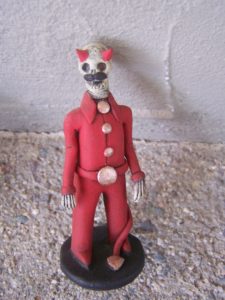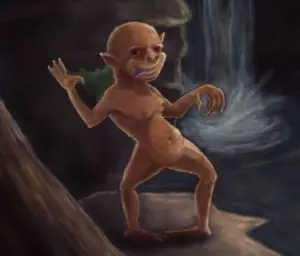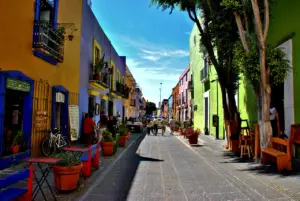Podcast: Play in new window | Download
Subscribe: Apple Podcasts | RSS
The Mexican state of Puebla is located in East-Central Mexico. It is bordered by the states of Veracruz to the north and east, Hidalgo, México, Tlaxcala and Morelos to the west, and Guerrero and Oaxaca to the south. The state’s capital, the city of Puebla, was founded in 1531 by the Spanish to serve as a midway stopover between Mexico City and the Gulf Coast. The region is rich in history and home to many legends, some going back hundreds of years. Here are seven.
- The Little Devil in the Church of San Miguelito
 The small chapel of San Miguelito is said to be the oldest church in Cholula, a city immediately to the west of the capital city of Puebla. Cholula is known as the site of the largest pyramid in the world. For more information about this monument, please see Mexico Unexplained episode number 26: https://mexicounexplained.com//cholula-largest-pyramid-world/ The small church dedicated to the archangel Saint Michael once had a magnificently carved statue of the saint near the altar. For those unfamiliar, Saint Michael is usually depicted brandishing his sword and battling with the devil. This statue was no different. Beneath the feet of this exquisite wood carving of Saint Michael was a red devil, but the devil was its own carving. People would come to this small church from the town and surrounding countryside to pray to the Saint Michael statue. Sometimes, though, they would say a prayer to the small devil just to cover their bases and make sure all their prayers were answered. Some locals frowned upon this practice because they believed that praying to the little devil carving was giving power to Satan himself. Soon, the bad things happening around town were attributed to the small devil, and some people claimed that they had seen the wooden figure at night, lurking about town. Indeed, sometimes the local priest or caretaker would claim to open up the chapel and find the devil sculpture missing, only for it to reappear in its familiar place beneath Saint Michael the next day or in different parts of the church. When a new priest took over the parish, he heard that locals would come to the chapel just to visit the devil to pray for love, money or revenge. The priest immediately got rid of the statue of Saint Michael and his accompanying devil and things briefly returned to normal in Cholula.
The small chapel of San Miguelito is said to be the oldest church in Cholula, a city immediately to the west of the capital city of Puebla. Cholula is known as the site of the largest pyramid in the world. For more information about this monument, please see Mexico Unexplained episode number 26: https://mexicounexplained.com//cholula-largest-pyramid-world/ The small church dedicated to the archangel Saint Michael once had a magnificently carved statue of the saint near the altar. For those unfamiliar, Saint Michael is usually depicted brandishing his sword and battling with the devil. This statue was no different. Beneath the feet of this exquisite wood carving of Saint Michael was a red devil, but the devil was its own carving. People would come to this small church from the town and surrounding countryside to pray to the Saint Michael statue. Sometimes, though, they would say a prayer to the small devil just to cover their bases and make sure all their prayers were answered. Some locals frowned upon this practice because they believed that praying to the little devil carving was giving power to Satan himself. Soon, the bad things happening around town were attributed to the small devil, and some people claimed that they had seen the wooden figure at night, lurking about town. Indeed, sometimes the local priest or caretaker would claim to open up the chapel and find the devil sculpture missing, only for it to reappear in its familiar place beneath Saint Michael the next day or in different parts of the church. When a new priest took over the parish, he heard that locals would come to the chapel just to visit the devil to pray for love, money or revenge. The priest immediately got rid of the statue of Saint Michael and his accompanying devil and things briefly returned to normal in Cholula.
- The Bridge of the Evil Elves
 The second-largest city in the Mexican state of Puebla is called Tehuacán. Founded in 1660 by the Spanish, the city is located in the southeastern part of the state. Tehuacán is home to a curious legend that dates back a few hundred years. It tells of a man named Hilario who was out drinking with his friends one night and walked home alone. On his walk he had to cross a bridge. While on the bridge, he saw a large white chicken. Hilario chased the chicken down the bridge but then noticed it was starting to transform itself into something else. The man stood there and before him appeared an angry-looking elf, sometimes locally called a chaneque. For more information about the history and meaning behind chaneques, please see Mexico Unexplained episode number 59: https://mexicounexplained.com//alux-chaneque-mexicos-elusive-elves/ When Hilario saw the chicken transform itself, he started to back away. The mad elf walked toward the man and was then joined by a dozen or so other elves that decided to jump Hilario and attack him mercilessly. The man managed to escape and told the locals what had happened to him. Hilario immediately left Tehuacán, never to return. The people of the city stay away from that bridge to this day. It is said at night one can hear the macabre chuckling of the little elves who live under that bridge.
The second-largest city in the Mexican state of Puebla is called Tehuacán. Founded in 1660 by the Spanish, the city is located in the southeastern part of the state. Tehuacán is home to a curious legend that dates back a few hundred years. It tells of a man named Hilario who was out drinking with his friends one night and walked home alone. On his walk he had to cross a bridge. While on the bridge, he saw a large white chicken. Hilario chased the chicken down the bridge but then noticed it was starting to transform itself into something else. The man stood there and before him appeared an angry-looking elf, sometimes locally called a chaneque. For more information about the history and meaning behind chaneques, please see Mexico Unexplained episode number 59: https://mexicounexplained.com//alux-chaneque-mexicos-elusive-elves/ When Hilario saw the chicken transform itself, he started to back away. The mad elf walked toward the man and was then joined by a dozen or so other elves that decided to jump Hilario and attack him mercilessly. The man managed to escape and told the locals what had happened to him. Hilario immediately left Tehuacán, never to return. The people of the city stay away from that bridge to this day. It is said at night one can hear the macabre chuckling of the little elves who live under that bridge.
- The Fountain of the Dolls
In the Xonaca neighborhood of the city of Puebla there stands a curious fountain enclosed in a cement structure that looks like a gazebo. The central feature of the fountain is a statue of two children, a boy and a girl, a brother and a sister. The girl is carrying schoolbooks and the boy used to be carrying an umbrella, but it broke off or was vandalized many years ago. The fountain is called by locals La Fuente de los Muñecos, or in English, The Fountain of the Dolls. The statues represent two local children of the Xonaca neighborhood, aged 6 and 7 who left home for school one morning in the middle of a rainstorm and never made it to school. In life the brother and sister were known as “Los Muñecos,” or “The Dolls” because their mother dressed them impeccably. On the fateful day of their disappearance, the whole neighborhood looked for the two children and found nothing. They disappeared without a trace. Rumors circulated that they fell down a deep well, but no bodies were ever found in any of the local wells. Some say that if you go to the fountain before the sun rises the statues of the children will be gone. Locals allege that during the night the statues come to life, filled with the spirits of the lost brother and sister. On some mornings, witnesses claim, the shoes of the statues have scuff marks on them and occasionally one of the statues will have what looks like a scraped knee. Some local children beg their parents to let them go out at night to play with the reanimated Muñecos, but most parents in the Xonaca neighborhood have the good sense to keep their kids indoors.
- The Alley of Death
In the city of Puebla, on a rainy night in 1785, Anastasio Priego, the owner of an old inn in the neighborhood of Analco, ran at full speed through the streets of the city in search of Doña Simonita, a midwife. Señor Priego was excited to locate the woman who could attend to his wife and receive his son. Right in the alley of Yllescas an assailant tried to take away all the belongings of the expectant father, who in self-defense killed the thug and left the body in the middle of the alley. Local residents say that the spirit of the dead appears right there, scaring passersby. Years later, on another rainy night of the same day of the year, Father Panchito was about to close the church of Analco when a man appeared at the church’s front door desperate to receive confession. The father agreed to listen to him and was surprised to discover that he was confessing to the many crimes that occurred in the Yllescas Alley, including the assault on the innkeeper who was rushing to find the midwife. The man spoke with Father Panchito for almost a half hour and regretted all the assaults he had committed. Once he received the absolution of his sins the figure of man vanished before the eyes of the priest.
- The Justice-Givers of the Los Sapos District
 The district of Los Sapos in the historic heart of the city of Puebla is home to an eclectic mix of shops, bars and restaurants. It is a colorful area of much joy and revelry, and people stay out enjoying the festive atmosphere of the place well into the wee hours. The locals tell cautionary tales of what happens to people who get carried away a little too much. The stories involve a dog and a beautiful young woman. The young women who have engaged in too much of the party atmosphere have to look out for a cute black puppy that will come up to them and tempt them to pet it. The innocent little dog turns into a vicious animal that bites at and strikes its victims with its gigantic paws. Young men need to be on the look out for a charming young woman who will lure men to a dark alley. When a man tries to kiss this beautiful woman, she turns into a horrible skeleton. Her victims are petrified and usaully die of heart attacks. So, the poblanos say, please be careful if you wish to spend a late night full of drink in the Los Sapos District, or you may run into these horrible creatures.
The district of Los Sapos in the historic heart of the city of Puebla is home to an eclectic mix of shops, bars and restaurants. It is a colorful area of much joy and revelry, and people stay out enjoying the festive atmosphere of the place well into the wee hours. The locals tell cautionary tales of what happens to people who get carried away a little too much. The stories involve a dog and a beautiful young woman. The young women who have engaged in too much of the party atmosphere have to look out for a cute black puppy that will come up to them and tempt them to pet it. The innocent little dog turns into a vicious animal that bites at and strikes its victims with its gigantic paws. Young men need to be on the look out for a charming young woman who will lure men to a dark alley. When a man tries to kiss this beautiful woman, she turns into a horrible skeleton. Her victims are petrified and usaully die of heart attacks. So, the poblanos say, please be careful if you wish to spend a late night full of drink in the Los Sapos District, or you may run into these horrible creatures.
- The Black Charro
In various parts of the city of Puebla – near the Main Theater, the Bridge of Mexico, the Atoyac River – many people have spotted a curious apparition. He is a very tall and handsome man dressed like a traditional Mexican charro, or cowboy, all in black. There are different versions of the story of the Black Charro, and hundreds of sightings of this magnificent specter have occurred throughout the city. There are those who claim it is a soul in sorrow, while others are more dramatic and associate it with the devil. Most say that if you speak to it, he offers you a great treasure in exchange for accomplishing a simple task that no one has been able to carry out. Those who speak with this cowboy apparition and attempt to comply with his wishes, usually end of missing, said to be carried off on the shoulders of this mysterious Charro.
- The Monster and the Wealthy Merchant
 Pedro de Carvajal was one of the wealthiest men in Puebla during the early colonial days. He had two children, a teenage daughter named Teodora and young son. His wife tragically died in childbirth while delivering their boy, so Don Pedro was raising his children alone, along with the help of nannies and servants. For several weeks one summer a hideous monster had been terrorizing the streets of Puebla at night. In some versions of the story the creature was a gigantic reptile that sometimes walked upright. In other versions it was a hairy, gigantic humanoid, much like the North American Bigfoot. The creature was supposedly created by a group of indigenous sorcerers who belonged to the Popoloca tribe who had grown weary of Spanish abuses and decided to manifest a monster to terrorize colonial settlements. One day, in broad daylight, Don Pedro’s son was attacked by the monster while playing in front of the Carvajal home. The creature carried away the boy to the mountains. The wealthy merchant offered a reward to anyone who caught the monster or killed it. An enterprising young man of low birth decided he would improve his station in life by taking up the cause of killing the Popoloca monster. The young man tracked down the creature, killed it and brought its head to the wealthy merchant’s home. In lieu of a reward of gold or other treasure, the young man asked for the hand of Teodora, the beautiful daughter of Don Pedro. The merchant agreed and they married, and Don Pedro gave the young man a generous dowry. After that, no more monsters roamed the streets of the city of Puebla.
Pedro de Carvajal was one of the wealthiest men in Puebla during the early colonial days. He had two children, a teenage daughter named Teodora and young son. His wife tragically died in childbirth while delivering their boy, so Don Pedro was raising his children alone, along with the help of nannies and servants. For several weeks one summer a hideous monster had been terrorizing the streets of Puebla at night. In some versions of the story the creature was a gigantic reptile that sometimes walked upright. In other versions it was a hairy, gigantic humanoid, much like the North American Bigfoot. The creature was supposedly created by a group of indigenous sorcerers who belonged to the Popoloca tribe who had grown weary of Spanish abuses and decided to manifest a monster to terrorize colonial settlements. One day, in broad daylight, Don Pedro’s son was attacked by the monster while playing in front of the Carvajal home. The creature carried away the boy to the mountains. The wealthy merchant offered a reward to anyone who caught the monster or killed it. An enterprising young man of low birth decided he would improve his station in life by taking up the cause of killing the Popoloca monster. The young man tracked down the creature, killed it and brought its head to the wealthy merchant’s home. In lieu of a reward of gold or other treasure, the young man asked for the hand of Teodora, the beautiful daughter of Don Pedro. The merchant agreed and they married, and Don Pedro gave the young man a generous dowry. After that, no more monsters roamed the streets of the city of Puebla.
The Mexican state of Puebla is rich in history and culture. There are many legends and stories here. Some are cautionary tales and some may be based on real events and people. All serve to inspire wonder and light up the imagination.
REFERENCES
The Matador Network web site and other online sources.
